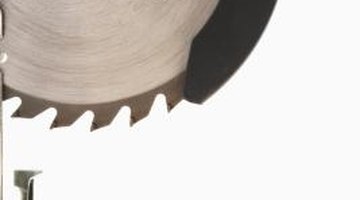What Type of Blade Cuts Medium-Density Fiberboard (MDF)?
It doesn't have a grain, but medium-density fiberboard (MDF) still is primarily composed of wood. It can be cut with any saw that you normally would use to cut wood. However, the adhesive that bonds the material's fibers is very hard and dulls saw blades quickly. Moreover, blades primarily intended for rough-cutting wood will chip the material's edges. Wear a mask when cutting MDF because it also produces a large quantity of toxic dust.
Composition of MDF

The primary material in MDF is derived from softwood, but manufacturers have successfully used other materials such as bamboo, waste paper and random waste wood. Manufacturers break these down into fibers much finer than those used in particle board through a process that includes chipping the wood, reducing it to pulp and then blowing it at a high temperature. To produce a more stable finished product, manufacturers also may combine wood fibers with glass, steel or carbon fibers. Manufacturers press these fibers together with a urea formaldehyde adhesive to produce MDF in sheets similar to plywood sheets.
Straight Cuts
Any carbide- or steel-tipped blade that will fit on a circular saw or a table saw will cut through MDF, but the blade should have more teeth than a regular utility blade for the best results. Blades with 60 or more teeth are preferable. The extra teeth prevent chipping, which is especially important when cutting MDF trim or molding. Carbide-tipped blades will last longer than steel-tipped blades and hold up better under the abrasive resistance of MDF. But carbide-tipped blades also have a wider kerf, or thickness, and might produce more chipping.
Curved Cuts
A jigsaw or reciprocating saw will cut MDF well with a wood-cutting blade. But the vibrations that these saws produce can be extreme, and wood-cutting blades probably will cause extensive chipping, too. Reduce the likelihood of chipping by using a metal-cutting blade instead. A shop tool such as a bandsaw or scroll saw won't produce as much vibration and either will work well with a wood-cutting blade. However, the heat produced when cutting curves, especially tight ones, together with the abrasive nature of MDF will dull the blades more quickly than if you were cutting wood.
Other Blades
You can cut MDF with a handsaw, but it will be slow going and hard on the blade. A pull saw will give more control and produce less chipping. Shaping edges of MDF with a router is not much different than doing it with regular wood, except that you must take precautions to protect your eyes from the vast amount of dust that the MDF will produce. There is another significant difference between MDF and wood to consider. The edges of MDF can't be planed with a hand plane or jointer without severe chipping.
Check out this related video from Homesteady on Youtube.
References
Writer Bio
Chris Deziel has a bachelor's degree in physics and a master's degree in humanities. Besides having an abiding interest in popular science, Deziel has been active in the building and home design trades since 1975. As a landscape builder, he helped establish two gardening companies.
Photo Credits
- Martin Poole/Digital Vision/Getty Images
More Articles



